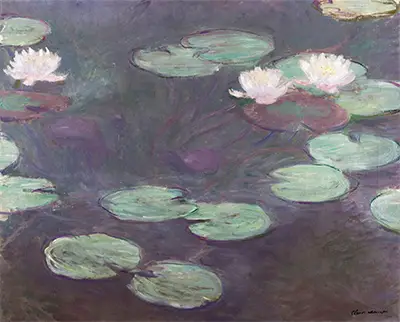The artist loved to experiment with different angles of his new garden, sometimes capturing his Japanese bridge, and on other occasions he would focus on a much smaller area, such as the painting found here. His lily pond would look differently across the year, as the flowers grew, blossomed, and then died away. They would also slowly float around the pond, creating new looks on an hourly basis. Light would also enter the garden from a variety of angles, due to the imposing trees that would block light out from certain positions. The lily flowers themselves would sometimes be entirely pink, as in this example, but other times would look lighter or darker. Monet would work expressively too, planning paintings to a certain degree, but also allowing room for drawing on his own emotions as he worked directly on the canvas.
Monet went through phases of work within his garden, often producing series of similar works, with just a few amendments between each one. At this point he was working on close ups of his lilies, attempting to translate their beauty onto the canvas. Colour was key here, and in this case he chooses pink tones for these stunning flowers, which works well against the darker purple tones that dominate most of this artwork. The greens then provide something of a middle ground. We see around 15 lily pods in this example, and with them slowly moving around over time, it is as if he has frozen his garden in time, just for a brief movement. He may well have taken a quick drawing in order to capture their positions, or perhaps even worked entirely from his own mind, which would have been possible considering the amount of time that he spent in his garden observing its different features.
This piece is dated at around 1897-1899 and this was an important period for Monet, when his garden has fully established itself and he was now able to work within an environment that felt completely natural, disguising how he had painstakingly designed each and every item within it himself. He therefore used this period to work extensively and produce many series of paintings from different viewpoints around the garden. He also developed the idea of what it was to be considered an Impressionist artist, taking his ideas in new directions and constantly experimenting with light and colour. In all, he would call upon a stunning palette of pinks, purples, blues, greens and whites as his most frequently chosen tones for these projects.


